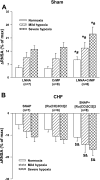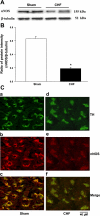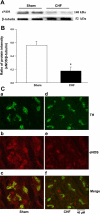Downregulation of carbon monoxide as well as nitric oxide contributes to peripheral chemoreflex hypersensitivity in heart failure rabbits
- PMID: 18356479
- PMCID: PMC2494830
- DOI: 10.1152/japplphysiol.01345.2007
Downregulation of carbon monoxide as well as nitric oxide contributes to peripheral chemoreflex hypersensitivity in heart failure rabbits
Abstract
Peripheral chemoreflex sensitivity is potentiated in clinical and experimental chronic heart failure (CHF). Downregulation of nitric oxide (NO) synthase (NOS) in the carotid body (CB) is involved in this effect. However, it remains poorly understood whether carbon monoxide (CO) also contributes to the altered peripheral chemoreflex sensitivity in CHF. This work highlights the effect of NO and CO on renal sympathetic nerve activity (RSNA) in response to graded hypoxia in conscious rabbits. Renal sympathetic nerve responses to graded hypoxia were enhanced in CHF rabbits compared with sham rabbits. The NO donor S-nitroso-N-acetylpenicillamine (SNAP, 1.2 microg x kg(-1) x min(-1)) and the CO-releasing molecule tricarbonyldichlororuthenium (II) dimer {[Ru(CO)(3)Cl(2)](2), 3.0 microg x kg(-1) x min(-1)} each attenuated hypoxia-induced RSNA increases in CHF rabbits (P < 0.05), but the degree of attenuation of RSNA induced by SNAP or [Ru(CO)(3)Cl(2)](2) was smaller than that induced by SNAP + [Ru(CO)(3)Cl(2)](2). Conversely, treatment with the NOS inhibitor N(omega)-nitro-L-arginine (30 mg/kg) + the heme oxygenase (HO) inhibitor Cr (III) mesoporphyrin IX chloride (0.5 mg/kg) augmented the renal sympathetic nerve response to hypoxia in sham rabbits to a greater extent than treatment with either inhibitor alone and was without effect in CHF rabbits. In addition, using immunostaining and Western blot analyses, we found that expression of neuronal NOS, endothelial NOS, and HO-2 protein (expressed as the ratio of NOS or HO-2 expression to beta-tubulin protein expression) was lower in CBs from CHF (0.19 +/- 0.04, 0.17 +/- 0.06, and 0.15 +/- 0.02, respectively) than sham (0.63 +/- 0.04, 0.56 +/- 0.06, and 0.27 +/- 0.03, respectively) rabbits (P < 0.05). These results suggest that a deficiency of NO and CO in the CBs augments peripheral chemoreflex sensitivity to hypoxia in CHF.
Figures







Comment in
-
NO and CO have got to GO for enhanced chemoreceptor sympathoexcitation in heart failure.J Appl Physiol (1985). 2008 Jul;105(1):1-2. doi: 10.1152/japplphysiol.90569.2008. Epub 2008 May 1. J Appl Physiol (1985). 2008. PMID: 18450975 No abstract available.
Similar articles
-
Role of blood flow in carotid body chemoreflex function in heart failure.J Physiol. 2011 Jan 1;589(Pt 1):245-58. doi: 10.1113/jphysiol.2010.200584. Epub 2010 Nov 15. J Physiol. 2011. PMID: 21078591 Free PMC article.
-
Exercise training improves peripheral chemoreflex function in heart failure rabbits.J Appl Physiol (1985). 2008 Sep;105(3):782-90. doi: 10.1152/japplphysiol.90533.2008. Epub 2008 Jun 26. J Appl Physiol (1985). 2008. PMID: 18583379 Free PMC article.
-
Enhanced peripheral chemoreflex function in conscious rabbits with pacing-induced heart failure.J Appl Physiol (1985). 1999 Apr;86(4):1264-72. doi: 10.1152/jappl.1999.86.4.1264. J Appl Physiol (1985). 1999. PMID: 10194212
-
Carotid body function in heart failure.Respir Physiol Neurobiol. 2007 Jul 1;157(1):171-85. doi: 10.1016/j.resp.2007.02.011. Epub 2007 Feb 16. Respir Physiol Neurobiol. 2007. PMID: 17374517 Free PMC article. Review.
-
Relevance of the Carotid Body Chemoreflex in the Progression of Heart Failure.Biomed Res Int. 2015;2015:467597. doi: 10.1155/2015/467597. Epub 2015 Dec 8. Biomed Res Int. 2015. PMID: 26779536 Free PMC article. Review.
Cited by
-
Inhibition of hydrogen sulfide restores normal breathing stability and improves autonomic control during experimental heart failure.J Appl Physiol (1985). 2013 May;114(9):1141-50. doi: 10.1152/japplphysiol.01503.2012. Epub 2013 Feb 28. J Appl Physiol (1985). 2013. PMID: 23449938 Free PMC article.
-
Pathophysiology and potential clinical applications for testing of peripheral chemosensitivity in heart failure.Curr Heart Fail Rep. 2014 Jun;11(2):126-33. doi: 10.1007/s11897-014-0188-6. Curr Heart Fail Rep. 2014. PMID: 24493575 Review.
-
Peripheral chemoreceptors: function and plasticity of the carotid body.Compr Physiol. 2012 Jan;2(1):141-219. doi: 10.1002/cphy.c100069. Compr Physiol. 2012. PMID: 23728973 Free PMC article. Review.
-
Elevated mitochondrial superoxide contributes to enhanced chemoreflex in heart failure rabbits.Am J Physiol Regul Integr Comp Physiol. 2010 Feb;298(2):R303-11. doi: 10.1152/ajpregu.00629.2009. Epub 2009 Nov 18. Am J Physiol Regul Integr Comp Physiol. 2010. PMID: 19923358 Free PMC article.
-
Inorganic nitrate supplementation attenuates peripheral chemoreflex sensitivity but does not improve cardiovagal baroreflex sensitivity in older adults.Am J Physiol Heart Circ Physiol. 2018 Jan 1;314(1):H45-H51. doi: 10.1152/ajpheart.00389.2017. Epub 2017 Sep 29. Am J Physiol Heart Circ Physiol. 2018. PMID: 28971842 Free PMC article. Clinical Trial.
References
-
- Bundock EA, Drummond GS, Kappas A. Tissue distribution of synthetic heme analogues: studies with tin, chromium, and zinc mesoporphyrins. Pharmacology 52: 187–198, 1996. - PubMed
-
- Chua TP, Ponikowski P, Webb-Peploe K, Harrington D, Anker SD, Piepoli M, Coats AJ. Clinical characteristics of chronic heart failure patients with an augmented peripheral chemoreflex. Eur Heart J 18: 480–486, 1997. - PubMed
-
- Chugh SS, Chua TP, Coats AJS. Peripheral chemoreflex in chronic heart failure: friend and foe. Am Heart J 132: 900–904, 1996. - PubMed
Publication types
MeSH terms
Substances
Grants and funding
LinkOut - more resources
Full Text Sources
Medical
Miscellaneous

